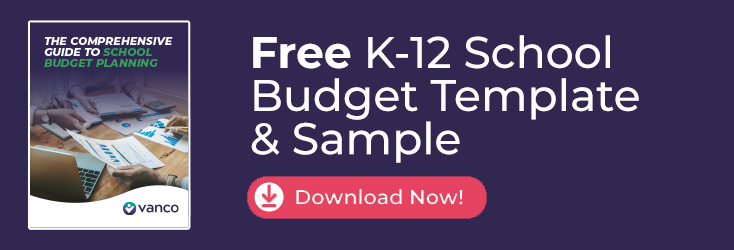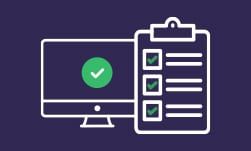
Budgeting education is probably the most labor-intensive and important project a school district's business office undertakes.
The school budget is not just a fiscal planning document or an expense tracking tool but a tangible deliverable of the district's educational promises to its community. Boards of education, superintendents, and administrative teams set all kinds of worthwhile educational goals for a district every year. However, no goals will be achieved if they aren't defined in the school's budget.
Fortunately, the process for developing a good budget, like elementary school budgets, is not complicated. While different regions and regulations affect certain aspects of the budget development process, the general steps are universal. This article will cover the basic steps and best practices for budgeting education.
Table of Contents
- Budgeting Best Practices for Educators and School Leaders
- Step-by-Step Guide to the School Budgeting Process
- Helpful Tools for School Budgeting (Includes Templates & More!)
- FAQs
Budgeting Best Practices for Educators and School Leaders
Preparing a school budget requires a solid foundation. The following best practices provide the base you need to get started.

Align Budgeting Goals with District Vision
Budgeting in education involves creating goals that align with the district vision, ensuring money is used wisely. The following tips will ensure success.
- Tie Budgets to Academic and Strategic Goals: The district may have various academic and strategic goals, including a focus on a safe and inclusive school environment, college and career readiness, individualized learning, community engagement and high-quality instruction. Determine your goals for the school year and ensure funding is dedicated to programs and strategies that support those goals.
- Fund Initiatives that Boost Student Success: The district may have various goals, but the most critical are those that boost student success. Although there is no direct relationship, schools with academic success tend to attract more funding opportunities. Determine which initiatives support students, and ensure your budget funds these programs.
- Review the Mission During Budget Planning: Budgeting teams should consider the mission in all aspects of district budget planning, ensuring their budget funds their goals.
Involve Stakeholders in Budget Decisions
Involving stakeholders in budgeting education decisions ensures satisfaction across the board. Here are the steps to ensure everyone's opinion is considered.
- Include Teachers, Parents and Students: Stakeholders don't just include financial experts, bookkeepers and executives at your school. They also include parents, teachers and students. Ensure their voices are heard to provide a happy educational community.
- Form Diverse Budget Advisory Groups: Advisory groups make recommendations on the school's budget. Don't limit your groups to government officials and experts. Consult community members and various stakeholders representing diverse cultural groups and genders to gather different insights.
- Collect Input Through Forums and Surveys: With so many groups to consider, gathering insights on various budgeting education matters may be difficult. Surveys and forums provide centralized information that can be referenced easily. You may also review surveys and forums outside your school to learn from others.
Use Historical Data and Enrollment Trends
Historical data and enrollment trends can guide your budgeting decisions. Here's how to utilize them for financial planning.
- Review 3-5 Years of Budget Data: Review budgeting education data from the past 3-5 years. Identify areas of under- and overspending to improve financial habits.
- Forecast Based on Enrollment Trends: Enrollment trends are crucial to budget forecasting for schools. The more enrolled students, the more funding the school will need to dedicate to academic success. Consider when enrollment goes up and down to distribute funds where needed most.
- Track Spending and Adjust Impact: While historical data and trends are important, financial planners must monitor spending and adjust habits in real time. Consider what's working and what's not, and adjust accordingly, even if you need to deviate from the initial plan.
Prioritize Transparency and Compliance
Transparency and compliance are necessary in a school setting, especially regarding financial matters. Here's how you can ensure a reliable process in your budgeting education approach.
- Share Budget Info in Plain Language: Avoid technical jargon during budget meetings. This language can confuse stakeholders, leading to a lack of transparency. Instead, explain concepts using words everyone can understand.
- Follow All Reporting Requirements: Schools are subject to various reporting requirements, such as reporting regularly, sharing financial statements at the end of the year, and holding public hearings when necessary. Understanding these requirements and including them in budgeting processes ensures compliance.
- Use Dashboards to Show Fund Use: Schools may consider investing in software that stakeholders can log into to view fund use. In addition to supporting budget transparency for schools, these centralized dashboards reduce questions that can increase administrative burden.
Develop a Budget Calendar
A budgeting education calendar keeps schools on track and ensures they have a solid plan for the coming school year. Here are some things to consider when planning your timeline.
- Set Key Planning and Approval Dates: Decide when financial planning will occur, ensuring presentations are ready by approval dates.
- Hold Check-ins Throughout the Year: Consider setting up monthly meetings to review the budget and determine what's working and what isn't. This approach allows you to make real-time changes and prepares you for upcoming financial planning.
- Allow Time for Public Input and Reviews: Schools should accept community input about their budget year-round. This input should be reviewed at meetings and may lead to updates that can impact scheduling.
Step-by-Step Guide to the School Budgeting Process
 Now that you know the best practices for creating a school budget, you can start the process. Follow these five steps to begin.
Now that you know the best practices for creating a school budget, you can start the process. Follow these five steps to begin.
Step 1. Forecast and Review Funding Sources
Budgeting in education requires forecasting and reviewing funding sources so schools can better understand where their money is coming from and where it's going. Here are some steps to keep in mind.
- Identify Funding Sources: The school must first identify its funding sources, which typically include state tax revenue, federal funding, grants and private donations. Financial planners should make a list of where funding is coming from and how much income they are likely to generate so that they can plan accordingly.
- Consider the Timelines: Schools should also consider when funding will arrive. This approach allows them to determine the best time to fund projects and launch initiatives.
- Optimize Funding: These insights may help the school identify additional funding sources, spread out expenses and cut back when necessary so they generate optimal income.
Step 2. Identify Fixed and Variable Expenses
Schools typically have two expense types, fixed, which stay the same, and variable expenses, which change. The following tips ensure smooth school financial management for both expenses.
- Plan far in advance for fixed expenses: Common fixed expenses include loan payments and memberships. Because these expenses are known and constant, plan and budget for them for in advance.
- Variable events fluctuate: Common examples include utility bills, program expenses and supplies. Schools should set a range for typical spending and ensure they have the maximum set aside to cover payments. If an excess is identified, it can be allocated to other sources.
- Consider Minimizing Variable Expenses: There's not much you can do to change fixed expenses, but you can save on variable expenses. For example, schools may consider reducing energy use to lower related bills. This approach allows schools to fund programs that promote student success.
Step 3. Evaluate Staffing and Program Needs
An NCES study of the 2020-21 school year reveals 87% of the $18,614 in expenditures go towards staffing, programs, and related needs like supplies and tuition. With staffing and program contributing so heavily to the school budget, they should be evaluated regularly to ensure they align with school goals. Here are some things to consider in the evaluation process.
- Staffing: School staff interact heavily with children and can make or break the school experience. Schools must hire experienced staff members and ensure they have enough to oversee family needs. However, they must also consider payroll expenses and avoid overstaffing to stay within budget.
- Programs: Various programs support academic success, including academic coaching, supplemental instruction, tutoring, study groups, mentoring and performing arts. Although costly, these programs enhance the student experience, promote better grades and make families happy.
- Consider Volunteers: While skilled staff is necessary, volunteers can be a money-saving solution for many schools. They can support programs and fulfill staffing needs without draining the school's budget. Students, parents and community members may be happy to volunteer to help the school and learn valuable skills.
Step 4. Draft, Review, and Approve the Budget
Budgeting typically requires a three-step process, as follows:
- Draft: Drafting is the first step. It involves assessing needs and goals, estimating revenue, and planning expenses. Once all information is gathered, it should be compiled in a clear format with documentation when necessary.
- Review: Next, the budget is made available for public review, typically 72 hours before a public hearing.
- Approve: The approval process includes the budget discussion hearing, which allows for public insight. If the budget seems balanced, the school board will approve it. Sometimes, the board superintendent will also review the budget before it's approved.
Step 5. Monitor and Adjust Throughout the Fiscal Year

Although budgets take careful planning, they may be adjusted throughout the year to meet evolving needs. Here are some ways you can ensure your budget is up to date.
- Regular Reviews: Set up a budgeting cycle for education, with monthly or quarterly reviews, and compare your planned budget against your actual spending and income. Analyze variables and investigate why they are occurring. Understanding the reason behind shifts provides insight into the financial aspects of the education industry.
- Make Informed Adjustments: Use your insights to make adjustments. For example, you may reallocate resources and revise forecasts based on your findings. Document the reasons for your changes to promote transparency.
- Leverage Tools: Various school budget planning tools can help you gain insights and support more effective budgeting. Schools may use software, apps, dashboards, and financial reports to understand their financial situation better. Automating can boost convenience and eliminate errors.
How to Present Your District's School Budget

Jim Rollo, business administrator at Morris County Vocational School District for 10 years, knows how to pitch a school budget. Vanco Education consulted Jim to get his best strategies.
A successful district budget presentation (it’s some sizzle and a lot of steak), can be broken down into three critical steps:
1) Remind
Show the board the current budget, including the district’s current budget year’s successes and accomplished goals.
2) Simplify
Present the budget, especially high-end items, in a way that non-financial experts on the board will understand.
3) Educate
Equip the board members with the information they need to answer questions from members of the public.
This “remind, simplify, educate” model makes school business administrators and finance staff feel confident, helping them improve their budget presentations.
Remind Board of Current Budget Goals & Accomplishments
“What you pretty much always want to do is explain that a budget is an educational spending plan,” Jim says. “It’s where the rubber meets the road of what the district’s goals are.”
It sounds simple, but you must remember that the school board sets the goals, and it’s the district’s administrative team’s job to accomplish them within the available funding. So, it’s smart to tell the board about all the district has accomplished with the current budget.
“I will start with a recap of the current budget. We’ll talk about the goals, and how the current budget went to address them,” he says. “Maybe we hired staff to implement the new gifted-and-talented program or an afterschool program to catch kids up academically.”
“Then you talk about what you hope to accomplish in the new year. That establishes continuity,” Jim adds.
Highlight what the district has done with its current funds, and how goals were met.
Simplify for Non-Financial Experts
“Your board is a mixed audience. You’re never going to be presenting to nine CPAs or nine business administrators,” Jim says.
Jim says you should explain how your budget actually works. Where is the money going?
“It’s all imaginary until you assign a dollar amount and a person to be responsible for it. A budget really is the implementation of the district’s goals — what a district wants to accomplish,” Jim explains.
Since not everyone on the board is a financial expert, the best budget presentations make the finances easy to digest.
“Everyone on the board is coming from a different background. So, you have to have that big-picture vision,” he says. “This is how we have allocated dollars in our current budget, how we will spend dollars in the new budget and how we will expand on that vision to get even better results.”
That doesn’t mean you should skip the details. Present your full budget plan, but make sure you present it in a way that is easy to understand.
Educate the Board to Speak with Taxpayers
Money is a touchy subject for taxpayers. In most places, the bulk of the district budget comes from taxpayers. So, it’s not uncommon for constituents to ask board members questions. This is especially true if taxes go up during a year to support a bigger education budget.
Jim suggests including a list of reasons the budget has grown in your presentation. Sometimes, it’s the mundane things that cause budget growth.
“At the end of the day, if a board member gets stopped in line at the grocery store and asked why taxes have gone up, they have a handy list of reasons. ‘Utility costs have gone up, the district had to hire ESL teachers, the auditorium hadn’t been renovated in 35 years,’ Jim says. “They have things at the top of their head.”
Empowering board members to give brief and accurate answers to members of the public will provide them with the confidence to inform taxpayers about the value the community is getting.
Again, Jim says, it doesn’t have to be a dollar-by-dollar breakdown. But with specific, clear, and accurate talking points, board members can give the public insight into your process.
“The board can feel like, ‘I can stand up to the taxpayer who questions me at the little league game or in the grocery store,’” Jim says.
By following this three-step presentation process, you will be able to accomplish the most important parts of a budget presentation: You will show the board your current successes, explain the budget’s major components, and give the board the confidence to discuss the budget’s main goals with constituents.
If your district wants to simplify all finances – and leverage continuing education management software to streamline budgeting and administrative tasks – speak with one of Vanco Education’s experts today. School finances are easier with Vanco.
Helpful Tools and Templates to Simplify School Budgeting
Editable Budget Templates (Downloadable Links + Guide)
Managing a K-12 budget is tough—especially with rising costs and less funding. That’s why we created this data-backed guide.
You’ll learn:
-
How principals can improve financial outcomes
-
Budget strategies with real-world success
-
How to prep for audits with our 105-point checklist
-
Tips to gain community support
-
Smart cost-saving ideas
-
Free budget template to get started today
Where to Find State Funding Guidelines
Funding guidelines vary from state to state and are available on each state's department of education website. Part of the difference is how states determine funding. They typically use one of three methods:
- By Students: They base funding on how much each student requires
- By Resources: They use resource needs to guide funding
- Hybrid Approach: This approach looks at student and resource needs and also considers tax income
The Elementary and Secondary Education Act (ESEA) also impacts funding and plays an important role in K-12 school finance as a primary source of federal aid for elementary and secondary schools. Central to the ESEA is Title I-A, which authorizes aid for disadvantaged students. However, it also has other titles that provide educational funding for staff members, English learners, rural communities and other aspects of education.
Federal Programs and Grants to Consider
Schools also draw funding from federal programs and grants. Here are some that your school may consider.
- Renew America's Schools: This program provides grants to schools, helping them reach their environmental goals. The 2025 program is contest-based, awarding schools that have made great strides in improving sustainability.
- Community Facilities Grants (Rural): This funding is awarded to rural schools to expand, construct, and improve their facilities so they can remain competitive with their urban counterparts.
- E-Rate (Schools and Library Program): This program helps schools and libraries obtain affordable broadband.
- Distance Learning & Telemedicine (DTL) Grants: This funding helps schools and other community organizations in rural areas connect with each other and the world to overcome isolation and low population density.
- Education Innovation & Research (EIR): This program provides funding to support achievement for high-need students.
Helpful Software for Budget Planning
Managing money for K-12 schools can be tough. Online payment systems like RevTrak can make it much simpler. in fact, 13,000 schools are using it today. Here's how these tools help:
Key Benefits
• Everything in One Place - Track all payments from sports teams, field trips, lunch programs and other activities in a single system
• See Money Coming In Right Away - Check how much money the school has received at any time, making it easier to plan ahead
• Save Time on Paperwork - Cut down the time spent matching payments to records from hours to just 10 minutes or less
• Works with Other School Systems - Connects directly with student information systems and accounting software, so everything stays organized
• Better District Budget Planning for the Future - Use detailed reports to understand spending patterns and predict future income more accurately
Why This Matters
When schools use online payment tools, finance teams spend less time on manual tasks and more time making smart budget decisions. This means more resources can go toward what really matters - helping students succeed.
See How It Works

Need help streamlining your school's financial planning and payments? Give us a call at 866-940-1352.
FAQs
What is budgeting in education?
Budgeting education involves determining school goals and expenses and ensuring the school has enough funding to cover them.
What are the common steps in a school budget process?
The common steps in a school budget process are:
- Drafting: Administrators draft a budget based on potential expenses and funding.
- Review: The budget is posted for public review.
- Approval: The budget is reviewed at a public hearing. If all goes well, the school board approves it.
How do schools estimate revenue for budgeting?
Schools estimate revenue for public school budgeting through the following processes:
- Historical Data: School administrators review data for the last few years to understand their typical revenue.
- Potential Funding: They consider potential funding that may come in throughout the year.
- Estimate: An estimate is made based on these figures.
What tools help educators plan school budgets?
Various tools can be utilized in budgeting for educators, including:
- Data Analysis: Administrators can use data analysis tools to review past budgets and predict current expenses and revenue.
- Automated Systems: Educators may integrate automated systems that create reports and perform calculations, reducing administrative duties and ensuring accuracy.
- Centralized Software: To support transparency, the school may utilize software that allows it to share financial information with stakeholders.
What are the biggest challenges in school budgeting?
Schools face several challenges in the budgeting process. The biggest may be:
- Unpredictable funding: Funding can be difficult to predict due to enrollment fluctuations and the economy.
- Resource Allocation: Schools may have a hard time determining which departments to prioritize in resource allocation.
- Low Funding: Schools often don't receive the funding they need to achieve desired goals.
What role do teachers play in budget planning?
Teachers are stakeholders in the budget planning process. They can provide insights into budgeting education needs based on their first-hand experience.

















